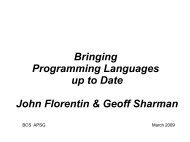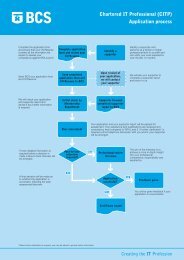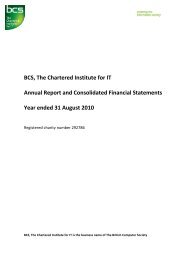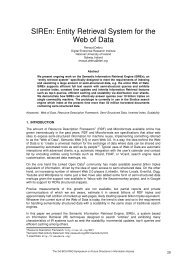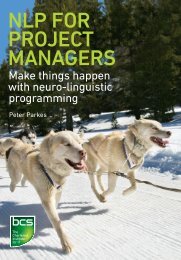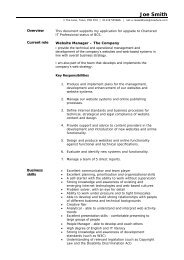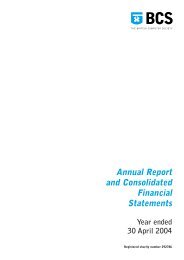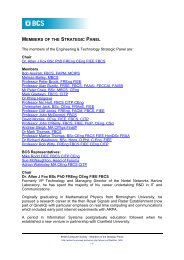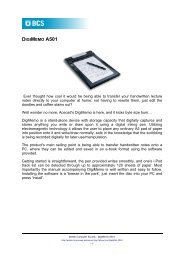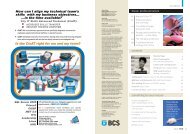Basic expert systems. - BCS
Basic expert systems. - BCS
Basic expert systems. - BCS
Create successful ePaper yourself
Turn your PDF publications into a flip-book with our unique Google optimized e-Paper software.
<strong>Basic</strong> <strong>expert</strong> <strong>systems</strong><br />
Keith Darlington MSc, M<strong>BCS</strong><br />
The Nursing Specialist Group<br />
Information Technology in Nursing<br />
Volume 8 1996<br />
Senior Lecturer in Knowledge Based Systems.<br />
The Knowledge Based Systems Centre<br />
South Bank University<br />
London<br />
WWW: http://www.scism.sbu.ac.uk/~darlink<br />
Key words: computer science, Diagnosis, Expert system.<br />
Summary<br />
An introduction to the basic concepts of <strong>expert</strong> <strong>systems</strong> and the characteristics which<br />
distinguish <strong>expert</strong> <strong>systems</strong> from conventional software. Some of the emerging uses of<br />
the technology that may be useful in the nursing professions are also discussed.<br />
Six references<br />
Medical software tools began to emerge during the 1980's, some became known as<br />
'<strong>expert</strong> <strong>systems</strong>'. In contrast to conventional software which process data, <strong>expert</strong><br />
<strong>systems</strong> process 'knowledge'. For this reason, <strong>expert</strong> <strong>systems</strong> are also called<br />
‘Knowledge Based Systems' (KBS). The most well known medical example is<br />
MYCIN.' This <strong>expert</strong> system was developed at Stanford University in 1976 to aid<br />
physicians in diagnosing and treating patients with infectious blood diseases caused<br />
by bacteria in the blood and meningitis. These diseases can be fatal if not recognised<br />
and treated quickly. Many other medical <strong>expert</strong> <strong>systems</strong> have followed the success of<br />
MYCIN. Other medical examples will be outlined later in the paper.<br />
What are <strong>expert</strong> <strong>systems</strong>?<br />
An <strong>expert</strong> system is a program, which attempts to mimic human <strong>expert</strong>ise by applying<br />
inference methods to a specific body of knowledge called the domain. Knowledge is<br />
different from data or information in that data is passive. Knowledge on the other<br />
hand is active in that it can be used to infer new information from what is already<br />
known about a problem. As will be seen later, this domain knowledge is frequently<br />
represented as rules.<br />
Artificial Intelligence Expert <strong>systems</strong> owe their origin to the field of Artificial<br />
Intelligence (AI). One of the pioneers of AI, Dr. Marvin Minsky defined AI as "The<br />
field of study which is attempting to build <strong>systems</strong> which if attempted by people<br />
would be considered intelligent". AI is a broad field, with some of the application<br />
areas shown in the diagram below.
Heuristics<br />
Expert <strong>systems</strong> are considered as a branch of AI because the method of problem<br />
solving is predominantly based on heuristics. This contrasts very much with the<br />
conventional programming paradigm that uses algorithms to solve problems. An<br />
algorithm is a step by step procedure that solves a category of problems. For<br />
example, algorithms may be used to process a company payroll. A typical algorithm<br />
would use a step by step procedure on the input data such as employee hours worked,<br />
overtime rate and so on, to generate output in the form of payslips for employees.<br />
The steps in this procedure involve direct manipulation of numeric data to produce<br />
information.<br />
Heuristics, on the other hand, solve a problem by trial and error guided by some<br />
reference to a predetermined goal. There are many examples that we may encounter<br />
in our daily lives. For example, a motorist searching a multi-storey car park for a<br />
parking space would not use an algorithm to find a space. There is no guarantee that<br />
whatever procedure is adopted a parking space will be found. The motorist may for<br />
instance, drive to the top-level first rather than searching each level in turn. Whilst<br />
this strategy may sound attractive there is no guarantee it will work: there may be no<br />
more spaces on the top-level available. The motorist then may have to try a lower<br />
level.<br />
Representing knowledge using rules<br />
As we have already seen, <strong>expert</strong> <strong>systems</strong> differ from conventional programming in<br />
that they process knowledge rather than data or information. This knowledge is<br />
frequently represented in a computer in the form of rules; they store the 'rules of<br />
thumb ‘that guide the human <strong>expert</strong>. For example, a typical rule used by the MYCIN<br />
<strong>expert</strong> system is
IF the stain of the organism is gram negative<br />
AND the morphology of the organism is rod<br />
AND the aerobicity of the organism is anaerobic<br />
THEN there is strongly suggestive evidence (0.8) that the class of the<br />
organism is Enterobacter iaceae.<br />
The inference engine<br />
The real forte of <strong>expert</strong> <strong>systems</strong> is their capacity to make inferences or the drawing of<br />
conclusions from premises. This is precisely what makes an <strong>expert</strong> system<br />
intelligent. Even when it is possible to represent domain knowledge as rules, a human<br />
<strong>expert</strong> would not only have to know how to apply these rules but in which order they<br />
should be applied to solve a particular problem. Similarly, a computer <strong>expert</strong> system<br />
would need to decide which, and in what order, the rules should be selected for<br />
evaluation. To do this, an <strong>expert</strong> system uses an inference engine. This is a program<br />
that interprets the rules in the knowledge base in order to draw conclusions. Two<br />
alternative strategies are available: backward chaining and forward chaining. A<br />
particular inference engine may adopt either or both.<br />
A backward chaining inference engine is 'goal-orientated' in the sense that it tries to<br />
prove a goal or rule conclusion by confirming the truth of all of its premises. Thus, to<br />
prove the conclusion of the rule above, MYCIN works backward by attempting to<br />
prove each premise., These premises may themselves be conclusions of other rules, in<br />
which case MYCIN would then try to confirm the premises of whatever rule it is the<br />
conclusion of, or the values of these premises may be data supplied by the user from<br />
clinical observations. In this way, a chain of inference steps will lead to a value for<br />
the goal being found. By contrast, a forward chaining inference engine starts from the<br />
other end. It examines the current state of the knowledge base and, finds those rules<br />
whose premises can be satisfied from known given data, and adds the conclusions of<br />
those rules to the knowledge base. It then re-examines the complete knowledge base<br />
and repeats the process, which can now progress further since new information has<br />
been added. Both the backward and forward inference process will consist of a chain<br />
of steps that can be traced by the <strong>expert</strong> system. This enables <strong>expert</strong> <strong>systems</strong> to<br />
explain their reasoning processes.<br />
Explanation facilities<br />
The ability to explain their reasoning processes are another key feature of <strong>expert</strong><br />
<strong>systems</strong>. Such explanation facilities provide the user with a means of understanding<br />
the system behaviour. This is important because a consultation with a human <strong>expert</strong><br />
will often require some explanation. Many people would not always accept the<br />
answers of an <strong>expert</strong> without some form of justification. For example, a medical<br />
<strong>expert</strong> providing a diagnosis and treatment of a patient would be expected to explain<br />
the reasoning behind his/her conclusions: the uncertain nature of this type of decision<br />
may demand a detailed explanation so that the patient concerned is aware of any risks,<br />
alternative treatments, and so on.<br />
The characteristics that distinguish <strong>expert</strong> <strong>systems</strong> from conventional <strong>systems</strong> are<br />
summarised in table 1.
Current applications of <strong>expert</strong> <strong>systems</strong><br />
A survey conducted by Waterman in 1986 showed that the majority of applications of<br />
<strong>expert</strong> <strong>systems</strong> that were built in the 1980's were in the field of medicine., Durkin<br />
suggested that <strong>expert</strong> <strong>systems</strong> in medicine still account for about 12% of those under<br />
current developments, However, other useful problem areas are emerging which lend<br />
themselves well to <strong>expert</strong> <strong>systems</strong>. These include: help desk <strong>systems</strong>, knowledge<br />
publishing, configuration and intelligent front-ends.<br />
Knowledge Publishing<br />
Knowledge Publishing is a growing application area of <strong>expert</strong> <strong>systems</strong>. The idea of<br />
knowledge publishing is encapsulated in the concept of a book. A book is a passive<br />
object in that it awaits us to read the part of interest. Knowledge Publishing delivers<br />
knowledge to the user actively, by providing what the user specifically requests.<br />
There are examples in common use that are disguised; that is, working within other<br />
<strong>systems</strong>. An example is GRAM@TIK the very popular grammar checker sold with<br />
WordPerfect software.<br />
Help desk applications<br />
Help desk <strong>systems</strong> are likely to be a key growth area in the future. Most help desk<br />
programs are <strong>expert</strong> system based and growth in this market is predicted at 20% -<br />
30% per annum. Large savings in time and costs can be achieved because people<br />
increasingly turn to the telephone when they have a problem rather than read<br />
manuals. The Compaq computer company now includes an online printer help desk<br />
program with all printers sold. The Quicksource program includes 5000 cases of
printer problems to help diagnose the printer fault and it is estimated that 20% fewer<br />
customers are telephoning the company for support. This has resulted in substantial<br />
savings for the company as well as a better service for its customers.<br />
Configuration<br />
The configuration system XCON is one of the most well known <strong>expert</strong> <strong>systems</strong> in use<br />
today. It was built by DEC corporation for turning customer orders into feasible<br />
VAX computer configurations. The system was completed in the early 1980's. It has<br />
been an enormously successful application and was followed by other large computer<br />
companies. Another new wave of configuration applications is beginning to emerge<br />
suited to 'mass customisation' applications.<br />
Intelligent front-end processors<br />
An Intelligent Front-End (IFE) is software which sits between a user and a<br />
conventional software program. An IFE uses KBS or AI techniques to make more<br />
effective use of software packages. Classical examples are found in database<br />
software. An IFE would provide an easier to use interface with the database for<br />
example, by permitting more flexible user dialogue. The IFE would do this by<br />
gaining an understanding of the user's requirements, and then using this specification<br />
to generate instructions for running the software package. The dialogue with the user<br />
will often be interactive. The IFE may also use a variety of techniques, particularly<br />
when carrying out the dialogue with the user to produce the specification of the user's<br />
problem. This idea has already been exploited in some commercial databases, such as<br />
'Superbase'.<br />
Examples of medical <strong>expert</strong> <strong>systems</strong><br />
While MYCIN is the most well known medical <strong>expert</strong> system another notable<br />
example is PUFF: An <strong>expert</strong> system that diagnoses the presence and severity of lung<br />
disease in a patient by interpreting measurements from respiratory tests administered<br />
in a pulmonary function laboratory. The data being interpreted include test results,<br />
for example, total lung capacity, and patient history. 1 Brain Tumors Diagnostic<br />
System (BTDS) is another <strong>expert</strong> system that assists a physician in the diagnosis of<br />
brain tumours.' BTDS consists of an <strong>expert</strong> system and a learning system. The former<br />
can help in judging the causes of brain tumours according to computed pictures. The<br />
latter is a learning method based on induction. Examples from known data are used to<br />
induce rules which represent the knowledge in the domain.<br />
The system was developed in Taiwan. Breast Cancer Diagnosis Application is an<br />
<strong>expert</strong> system that was developed for early detection of breast cancer.' The system<br />
undertakes a dialogue with a woman who is anxious about breast cancer. The ensuing<br />
conversation is divided into two parts: one is listening to the woman's symptoms<br />
regarding the breast then giving advice, the other is an explanation of the breast<br />
cancer and how to detect it in its early stages. After listening to the woman's<br />
symptoms, the system presents its conclusions and suggests courses of action that the<br />
woman should take. This system was developed in Japan.
References<br />
1. Shortliffe EH. Computer Based Medical Consultations: WCIN. New York:<br />
Elsevier, 1976.<br />
2. Waterman DA. A Guide to Expert Systems. Addison-Wesley Publishing<br />
Company, 1986.<br />
3. Durkin J. Expert Systems: Catalogue of Applications. Intelligent Computer<br />
Systems, PO BOX 4117, Akron, Ohio, USA, 1993.<br />
4. Aikens J S. PUFF: An <strong>expert</strong> system for interpretation of pulmonary function data.<br />
Computers and Biomedical Research<br />
1983;16: 199-208.<br />
5. Wang CH, Tseng SS. A brain tumour diagnostic system with automatic learning<br />
abilities. Proceedings of the 3rd Annual IEEE Symposium on Computer Based<br />
Medical Systems. Chapel Hill, NC 1990: 313-20.<br />
6. Morio S. An <strong>expert</strong> system for early detection of cancer of the breast. Computers in<br />
Biology and Medicine 1989;<br />
9.5: 295-306.<br />
Accepted: June 1996




